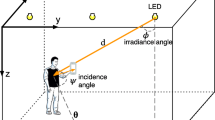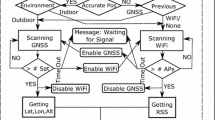Abstract
In this paper, an indoor positioning method, namely LiPro, is proposed for handheld devices such as smartphones. Based on an empirical light intensity model, we propose a rotating multi-face positioning method that enables a receiver to locate itself in ill-conditioned scenarios which would otherwise make the traditional multilateration impossible—for example when less than three LED lamps are visible to the receiver. In this method, the user manually performs three rotations of the receiver around three orthogonal axes, in a manner similar to the calibration process of a compass. During this process, the receiver continuously collects RSS and magnetic field strength, which are then used to solve for the receiver’s position. LiPro can work with a single source of light, making it a more cost-effective and less demanding than previous approaches. Our experiments show that LiPro achieves a median error of 0.59 m in a corridor with linearly deployed LEDs, and 0.45 m in an office. Moreover, LiPro is shown to be robust against interference from ambient light sources.


















Similar content being viewed by others
References
Bahl, P., & Padmanabhan, V. N. (2000). Radar: An inbuilding RF-based user location and tracking system. In INFOCOM.
Barry, J. R. (1994). Wireless infrared communications (Vol. 280). Berlin: Springer.
ByteLight. http://www.bytelight.com/.
Chen, Y., Lymberopoulos, D., Liu, J. & Priyantha, B. (2012). FM-based indoor localization. In ACM MobiSys.
Chintalapudi, K., Iyer, A. P., & Padmanabhan, V. N. (2010). Indoor localization without the pain. In Mobicom.
Chung, J., Donahoe, M., Kim, I., Schmandt, C., Razavi, P., & Wiseman, M. (2011). Indoor location sensing using geo-magnetism. In MobiSys.
Intersil (July 2012). The ISL29023 datasheet.
Kotaru, M., Joshi, K., Bharadia, D., & Katti, S. (2015). Spotfi: Decimeter level localization using wifi. In SIGCOMM.
Kumar, S., Gil, S., Katabi, D., & Rus, D. (2014). Accurate indoor localization with zero start-up cost. In MOBICOM.
Kuo, Y., Pannuto, P., Hsiao, K.-J. & Dutta, P. (2014). Luxapose: Indoor positioning with mobile phones and visible light. In ACM Mobicom.
Li, L., Hu, P., Peng, C., Shen, G., & Zhao, F. (2014). Epsilon: A visible light based positioning system. In Proc. NSDI.
Mariakakis, A. T., Sen, S., Lee, J., & Kim, K.-H. (2014). Sail: Single access point-based indoor localization. In Proc. of MobiSys.
Niculescu, D., & Nath, B. (2003). Ad hoc positioning system (APS) using AOA. In IEEE INFOCOM.
Niculescu, D. & Nath, B. (2004). Vor base stations for indoor 802.11 positioning. In ACM Mobicom.
Nirjon, S., Liu, J., & DeJean, G. (2014). Coin-gps: Indoor localization from direct gps receiving. In ACM MobiSys.
Ozyagcilar, T. (2015). Implementing a tilt-compensated eCompass using accelerometer and magnetometer sensors. In Freescale semiconductor.
Prince, G. B. & Little, T. D. (2012). A two phase hybrid RSS/AOA algorithm for indoor device localization using visible light. In IEEE global communications conference (GLOBECOM).
Priyantha, N. B., Chakraborty, A., & Balakrishnan, H. (2000). The cricket location-support system. In MobiCom.
Rajagopal, N., Lazik, P. & Wowe, A. (2014). Visual light landmarks for mobile devices. In IPSN.
Sahinoglu, Z., Gezici, S., & Guvenc, I. (2008). Ultra-wideband positioning systems: Theoretical limits, ranging algorithms, and protocols. Cambridge: Cambridge University Press.
Sen, S., Choudhury, R. R., & Nelakuditi, S. (2012). Spinloc: Spin once to know your location. In HotMobile.
STMicroelectronics (2010). Using LSM303DLH for a tilt compensated electronic compass, AN3192 application note.
Turner, D., Savage, S. & Snoeren, A (2011). On the empirical performance of self-calibrating wifi location systems. In Local computer networks (LCN).
Varshavskya, A., Lara, E. D., Hightower, J., LaMarca, A., & Otsason, V. (2007). Gsm indoor localization. In Pervasive and mobile computing.
Wang, J., Adib, F., Knepper, R., Katabi, D., & Rus. D. (2013) RF-compass: Robot object manipulation using rfids. In ACM Mobicom.
Wang, J., & Katabi, D. (2013). Dude, where’s my card?: RFID positioning that works with multipath and non-line of sight. In Proc. of ACM SIGCOMM.
Wu, K., Xiao, J., Yi, Y., Gao, M., & Ni, L. M. (2012) Fila: Fine-grained indoor localization. In IEEE INFOCOM.
Xiong, J., & Jamieson, K. (2013) Arraytrack: A fine-grained indoor location system. In Usenix NSDI.
Yang, L., Chen, Y., Li, X.-Y., Xiao, C., Li, M., & Liu, Y. (2014). Tagoram: Real-time tracking of mobile RFID tags to high precision using cots devices. In Proc. of Mobicom.
Yang, S.-H., Jeong, E.-M., Kim, D.-R., Kim, H.-S., Son, Y.-H., & Han, S.-K. (2013). Indoor three-dimensional location estimation based on led visible light communication. Electronics Letters, 49(1), 54–56.
Yoshino, M., Haruyama, S., & Nakagawa, M. (2008). High-accuracy positioning system using visible led lights and image sensor. In IEEE radio and wireless symposium.
Youssef, M., & Agrawala, A. (2005). The horus wlan location determination system. In MobiSys.
Yun, S., Chen, Y.-C., & Qiu, L. (2015). Turning a mobile device into a mouse in the air. In MobiSys.
Zhou, Z., Kavehrad, M., & Deng, P. (2012). Indoor positioning algorithm using light-emitting diode visible light communications. Optical Engineering. doi:10.1117/1.OE.51.8.085009.
Acknowledgments
Guang Tan’s work was supported in part by NSFC Grant No. 61379135, Shenzhen Scientific Research Fund No. CXZZ20151117161747567, Shenzhen Overseas High-level Talents Innovation and Entrepreneurship Funds No. KQCX20140520154115026, Shenzhen Fundamental Research Program under Grant No. JCYJ20140610151856733.
Author information
Authors and Affiliations
Corresponding author
Rights and permissions
About this article
Cite this article
Xie, B., Gong, S. & Tan, G. LiPro: light-based indoor positioning with rotating handheld devices. Wireless Netw 24, 49–59 (2018). https://doi.org/10.1007/s11276-016-1312-1
Published:
Issue Date:
DOI: https://doi.org/10.1007/s11276-016-1312-1




